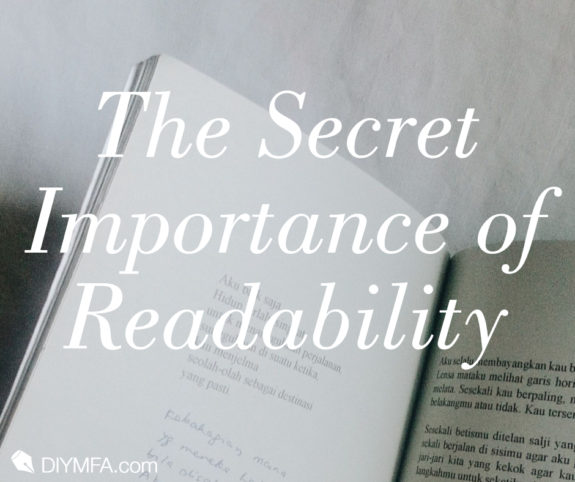The importance of readability in a novel is an exhaustive conversation, but a necessary one for writers wanting to sell books. Word processing and editing programs offer a wide variety of grade level and reading ease scales to determine who might be able to read and understand your work. Some writers analyze this closely while others discount it as trivial.
So, what do these systems mean? Are they really important when we edit? Will writing “down” to our readers turn them off? Reading ease is proven to have an important correlation to how well a book sells. Read on to find out.
Readability Scales
But first, let’s look at the systems commonly used to “grade” your writing.
Why are there so many? Some were developed for specific purposes such as medical writing or military manuals. In other cases, someone just thought they had a better idea. Each system is a formula potentially consisting of word count, syllables, characters, and sometimes even whole clauses. Editing software such as Microsoft Word, Grammarly, and ProWritingAid apply a variety of these scales to your writing. Here’s the breakdown:
Flesch Reading Ease
Scored from 0 (really difficult) to 100 (super easy), this scale uses word and sentence length to determine readability. It is one of the most widely available and reliable systems for novels, technical manuals, and everything in between.
Flesch–Kincaid Grade Level
Developed for the Navy, this system is the US Army Standard for grading technical manuals and is widely used in education. There are even laws saying auto insurance policies have to be written no higher than an F-K 9th-grade level to be legally binding.
Gunning Fog Index
Developed by a newspaper and publishing expert, this index determines the years of formal education necessary to understand a text. A score of 12 is considered a wide audience. A score of less than 8 indicates near-universal readability.
Automated Readability Index
Like above, the ARI determines the readability of a text and assigns it a grade corresponding to US schooling levels. However, this is one of only two which use characters per word (more accurately counted by computers) rather than syllables per word.
Coleman-Liau
Like the ARI, this readability index uses characters per word, rather than syllables per word. The scale corresponds to US grade levels.
SMOG Grade
SMOG—Simple Measure of Gobbledygook—calculates a text’s readability using a surprisingly easy formula. This is considered the gold standard for grading healthcare-related materials.
Dale-Chall
This system measures readability based on sentence length and use of “hard” words—everything excluding a list of nearly 3000 words easily understood by 4th graders. It’s used widely in education and scientific writing.
Do These Scales Matter?
In short, yes.
English has been condensed. The average printed sentence in Elizabethan times was 50 words long. The average printed sentence in the 1880’s was 23 words long. People in the 19th century were not dumb but were rather plagued by a lack of understandable reading material. As English changed, the readability of texts rose and knowledge began to spread.
In 1935, What Makes a Book Readable was published and made waves, so much so that it’s one of the foremost authorities on readability still today. Research into the reading skills of Americans showed the average reading level was below 8th grade (7.8 to be exact). When compared to the average readability of books, magazines, and newspapers at the time, researchers concluded that “there is clearly a lack of material interesting to adults and yet within the grasp of the unskilled reader.”1
I know what you’re thinking…that was 1935. Surely, it’s different now. Well, modern adult literacy examinations show that 43% of adults in the US (about 93 million people) have basic or below basic literacy levels. Still today, adults need reading materials at a level they can easily read and enjoy.
Wouldn’t That Be Writing Down to Some Readers?
This has long been the argument of writers who choose to ignore these scales or even purposefully write in a way to elevate their text for a higher-educated reader. But I’m guessing you may not realize some of your favorite books were actually written at a grade school level. Books by Cormac McCarthy, Jane Austen, Herman Melville, and Hunter S. Thompson all fall within the reading ease of pre-teens. Surprised?
True, not many adults would hand an 8th grader Fear and Loathing in Las Vegas, yet it’s fully within their reading capability. That’s because readability scales only look at the style of the text, not the content. This is where the main distinction lies and why it’s not demeaning to write at a lower grade level than your target audience.
We’ve been trained to think that better writing corresponds to a higher grade level, but readers enjoy books more (as evidenced by commercial popularity) when they’re easy to read, even if the subject matter is for adults only. Reading is an escape. Adult readers want an easy experience where they can enjoy what you are saying, and not trip over how you are saying it. Universal readability (about 8th-grade level) is recommended to reach the widest audience possible.
Darn. So, I Do Need to Pay Attention to Readability.
Yup, looks like it. Readability and grade level scores are important for every writer. Whether you’re writing an early-reader book for kids or a steamy romance novel for adults only, research your target audience and look at what they are already reading. Check the grade level or readability score of these texts and evaluate and revise yours accordingly.
Editing is a lot of work and it’s not fun to throw yet another consideration on top of everything you already need to be doing, but don’t panic. First, there’s no direct correlation between your own personal education and the complexity of your narrative writing style. Which means you may be writing at a grade level lower than you expected or even intended. Second, most of the basics of editing (cutting down word count, revising for clarity, etc.) will naturally make a text easier to read. Keep checking your readability as you revise and it’s sure to change.
Remember, while readability is important, you can’t edit to the point where your content suffers. No scale can measure how compelling a character is or how beautifully a theme is conveyed. Those are the things that make your work a reflection of your unique style. Use your own best judgment but be sure to at least give your reading ease or grade level a look. You may be surprised by what you find.

Jeanette the Writer is an editor, coach, and freelance writer who wants to help others demolish their editing fears and finish their manuscript. As a former scuba instructor turned entrepreneur, Jeanette knows about putting in the hard work to pursue your passions. She has worked with authors, speakers, coaches, and entrepreneurs—empowering them with the right mindset, knowledge, and tools to help them tackle their editing goals. You can learn more about Jeanette by visiting JeanetteTheWriter.com.







